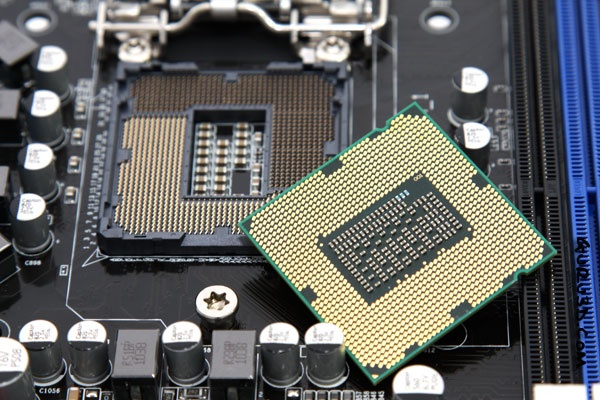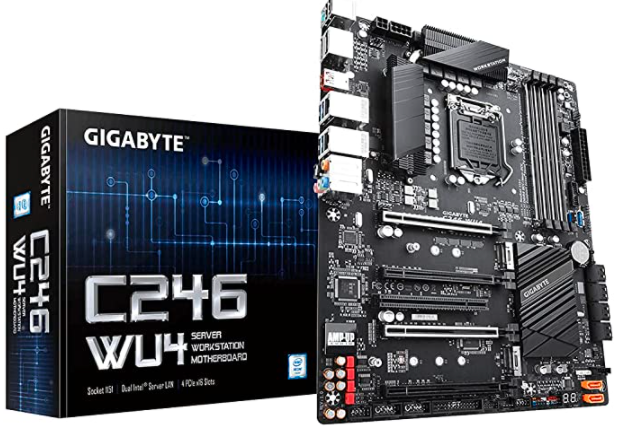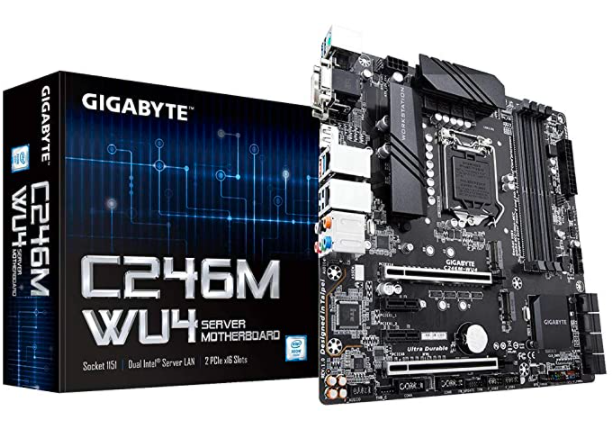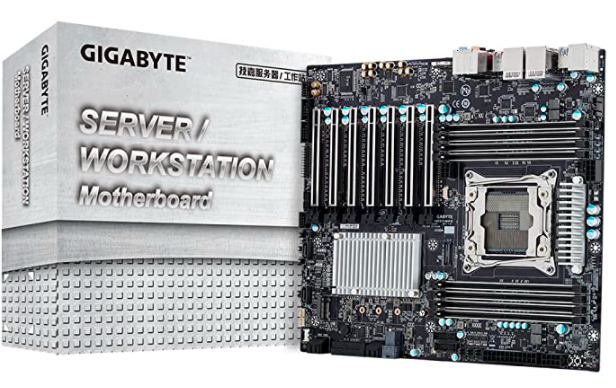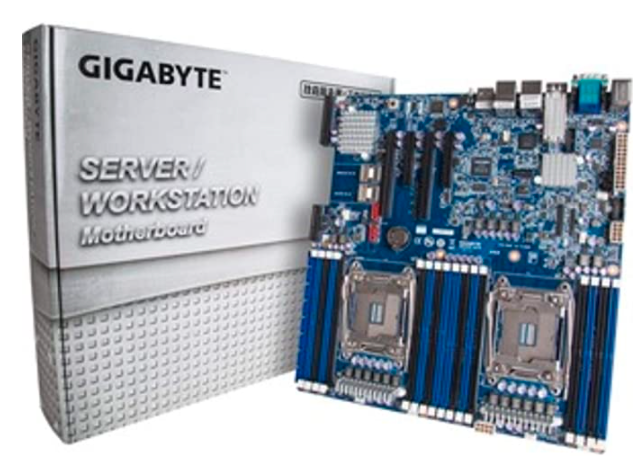The Gigabyte server motherboards article compares motherboards, a core component of any computer, from two of the best-selling manufacturers.
Best Gigabyte Server Motherboards In 2022
Both Gigabyte are two giants when it comes to everything related to computing. These companies have a wide product line, ranging from peripherals to complete systems.
GIGABYTE C246-WU4
About this item
- Supports Intel 1151 Xeon E processors and 9th/8th Gen. Intel Core/ Pentium/ Celeron processors
- Supports DDR4 ECC & non-ECC Un-buffered Memory
- 4 PCIe x16 slots for multi cards, support for AMD Quad-GPU Crossfire and 4-way AMD Crossfire technologies
- Dual Intel Server GbE LAN support Intel vPro Technology
- Large storage capacity: 10 SATA3 Ports
GIGABYTE C246M-WU4
About this item
- Supports Intel 1151 Xeon E processors and 9th/8th Gen. Intel Core/ Pentium/ Celeron processors LGA1151
- Supports DDR4 ECC & non-ECC Un-buffered Memory
- 2 PCIe x16 slots & 2 PCIe x1 slots
- Dual Intel Server GbE LAN support Intel vPro Technology
- Large storage capacity: 8 SATA3 Ports
Gigabyte MW51-HP0
About this item
- Intel Xeon W-series Processor Family
- Intel C422 Express Chipset
- Quad Channel RDIMM/LRDIMM DDR4, 8 x DIMMs
- Intel VROC ready
- AS Media 2142 USB 3.1 Gen 3 controller
Gigabyte Motherboard MD60-SC0
About this item
- Dual LGA 2011-v3
- Chipset: Intel C612
- Memory: 16x DDR4-2133/1866/1600 DIMM Slots, Quad-Channel, ECC, Non-ECC, REG, Support Single and dual rank RDIMM modules up to 32GB, Support Quad rank LRDIMM modules up to 64GB
- SATA: 10x SATA3 Ports (2 Support SATA DOM, 8 via 2x Mini-SAS), Support RAID 0, 1, 5, 10
- Power Connector: 1x 24pin ATX Main Power Connector, 2x 8pin ATX 12V Power Connectors
Source: gigabyte.com
Gigabyte Motherboard – Comparative Analysis
Before we dive into the details of two representative motherboards from these companies, let’s look at an overview of the motherboards they offer.
Gigabyte divides its motherboards into 5 main categories.
AORUS Gaming motherboards are for extreme gaming enthusiasts. Whereas Gigabyte Gaming motherboards are mid-range motherboards that can handle most gaming tasks.
Ultra-durable motherboards are for extreme conditions and connectivity options.
While for server computers, Gigabyte offers server / workstation motherboards with suitable processing and connectivity options.
Lastly, Embedded / IoT motherboards are best suited for on-board computers that focus on Internet of Things applications.
In contrast, gigabyte divides its motherboard range into 8 main categories. Of these 8 categories, ROG, TUF Gaming and Pro Gaming motherboards are specially designed for gaming. However, the ProArt, Prime, and TUF – The Ultimate Force motherboards are better suited for general high-computing tasks. Apart from these, commercial and workstation motherboards are also available from gigabyte.
These motherboards are comparatively inexpensive and can provide adequate connectivity options for the user.
Both the Gigabyte motherboards use chipsets from Intel, AMD, and Nvidia.
Gigabytes using the NVidia chipset are the best gaming motherboards you can find on the market.
Both companies offer a good number of options for various types of applications. So it is up to you to choose one from the list. According to the general perception, GigaByte motherboards outperform gigabyte motherboards.
They are more robust and resistant, while gigabyte motherboards sometimes fail under difficult conditions. For a motherboard, the harsh conditions are extreme gaming, graphics software, and cryptocurrency mining. Let me end this section by saying a word in favor of gigabyte motherboards, they are priced considerably lower.
Parts Of A ,Motherboard
Now that we know what a motherboard is for and how it works , let’s see the different parts that make it up:
- It also receives the socket name and that is where the corresponding CPU is embedded. It is very important that both share the nomenclature and are compatible.
- It is a set of electronic circuits that are responsible for managing data transfers between the different components of the computer. It is divided into two sections, called northbridge and southbridge . In current boards, the former is usually integrated into the processor encapsulation.
- Power connectors. Through them, electrical energy is provided to the different components of the motherboard, always attending to their different voltages.
- RAM memory slots. The motherboard also have a series of slots or grooves where connecting random access memory (RAM) .
- This element is responsible for regulating the speed of the executions that occur both in the CPU and in the rest of the peripherals.
- Expansion slots. They are a set of slots or slots where expansion cards can be connected in order to increase the performance of the computer. The PCI-Express 0 x16 are the most recent and is where the GPU are connected.
- Input and output connectors, among which the USB ports, VGA, DVI, HDMI or DisplayPort inputs, as well as Serial ATA (SATA) connectors for hard and solid drives, M.2 for the new NVMe and outputs of audio jack .
- BIOS. It is the startup program with which some basic parameters of the PC can be adjusted , currently called UEFI .
What Types Of Motherboards Are There?
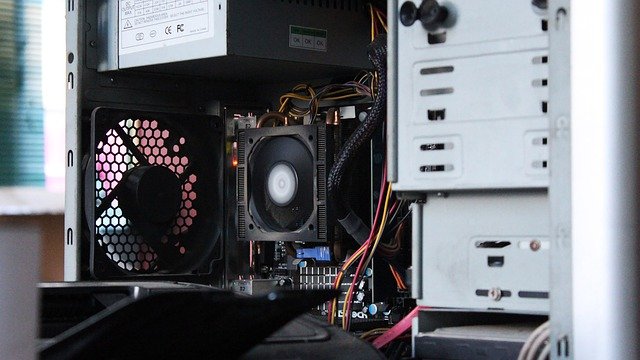
After listing all the parts of a motherboard , let’s now know the different types that exist and which are the most popular. Most are divided into what is known as form factor , which are the standards that define some physical characteristics of this component, such as its size and orientation with respect to the case, the type of power supply or the distribution of the devices. Integrated. According to this classification, we can differentiate between:
XT Motherboards
They were the first to be manufactured, in 1983, and receive this name from the acronym ‘eXtended Technology’. They were used primarily for the first IBM PC XT computers. These plates were the same size as an A4 sheet and had only one external connector for the keyboard.
AT Motherboards
A year later AT ( Advanced Technology ) motherboards emerged . They were the ones that had a larger format in the history of the PC, since they were divided into two parts. They were used from 1984 to 1995.
ATX Motherboards
From that moment Intel developed the motherboards ATX or Advanced Technology eXtended . They were the first to have external connections along with a 24-pin power connector. It is currently the most widely used for any type of computer. Within this group are also the Micro-ATX , Mini ATX and E-ATX.
ITX Motherboards
In 2001 ITX ( Integrated Technology eXtended ) motherboards emerged . On paper they had the same specifications as Intel’s MicroATX , with the particularity that their design allows for the integration of a greater number of components.
DTX Motherboards
Lastly, we find the DTX motherboards. This model came out in 2007 and, above all, it is intended for mini-PCs . It is, therefore, an ideal option for those who want to build a small computer. These boards have a 24-pin power connector and an additional 2×2.
What Motherboard Can We Buy?
After reading these lines, you may have a question : which motherboard is best for me to mount a gaming PC ? Well, like everything in life, it depends a bit on the budget you have and the CPU you want to use.
With the great rise of Ryzen CPUs , more and more users have opted for these processors , as they offer more than remarkable performance at a fair price.
You can also opt for Intel, which has regained prominence in the sector with the successor of the socket of motherboard 1151. Very necessary thing, especially when AMD began to show itself in the mirror.

